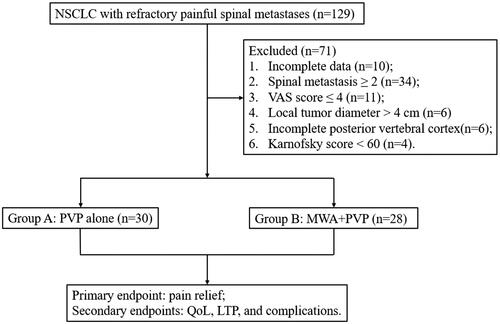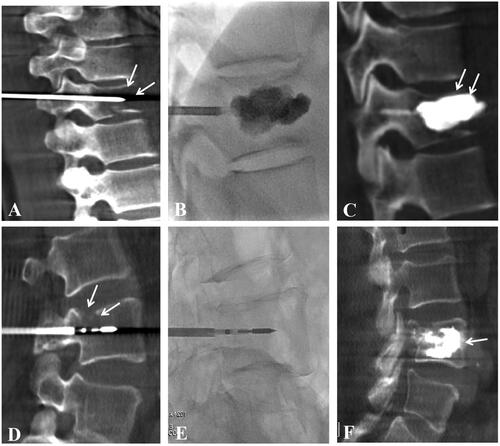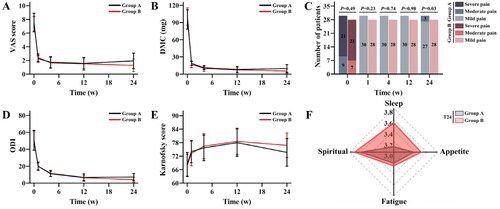Figures & data
Figure 1. the workflow Schematic diagram of this study. NSCLC, non-small cell lung cancer; VAS, visual analog scale; MWA, microwave ablation; PVP, percutaneous vertebroplasty; QoL, quality of life; LTP, local tumor progression.

Table 1. Baseline clinicopathological characteristics of patients in both groups.
Figure 2. A 61-year-old Female patient with thoracic vertebra 10 (T10) metastases from NSCLC, and VAS score was 7 at pre-procedure (A-C). (A) the 13 G puncture needle was inserted into the T10 under the guidance of C-arm computed tomography (CT) and fluoroscopy, and intra-operative C-arm CT showed that metastases damaged the integrity of the T10 (arrow); (B) bone cement was slowly injected under real-time fluoroscopy; (C) intra-operative C-arm CT showed adequate filling of the bone cement in the T10, and the VAS score decreased to 2 at 1 week evaluation. Another 57-year-old male patient with lumbar vertebra 4 (L4) metastases from NSCLC, and VAS score was 8 at pre-procedure (D-F). (D) the 13G puncture needle was inserted into the L4 under the guidance of C-arm CT and fluoroscopy, intra-operative C-arm CT showed that metastases damaged the integrity of the L10 (arrow), and a MWA applicator was inserted into the L4 by coaxial technology; (E) the location of puncture needle and applicator were confirmed by real-time fluoroscopy; (F) intra-operative C-arm CT showed adequate filling of the bone cement in the L4, and the VAS score was reduced to 2 at 1 week evaluation.

Table 2. Intraoperative and postoperative parameters from different therapy strategies.
Figure 3. Changes of the indicators in both groups at different times. (A) trends in visual analog scale (VAS) scores over time in both groups; (B) trends in daily morphine consumption (DMC) over time in both groups; (C) stratification analysis of VAS grades between two groups at different times; (D) trends in Oswestry Disability Index (ODI) over time in both groups; (E) trends in Karnofsky score over time in both groups; (F) at 24 weeks (T24), comparison of sleep, appetite, fatigue, and spiritual scores between two groups.

Table 3. Pain relief and ODI evaluation at both groups.
Table 4. Univariable and multivariable analyses of predictors of cement leakage.
Supplemental Material
Download PDF (255.5 KB)Data availability statement
In addition to the raw data in the manuscript, the datasets used are available from the corresponding author on reasonable request.
